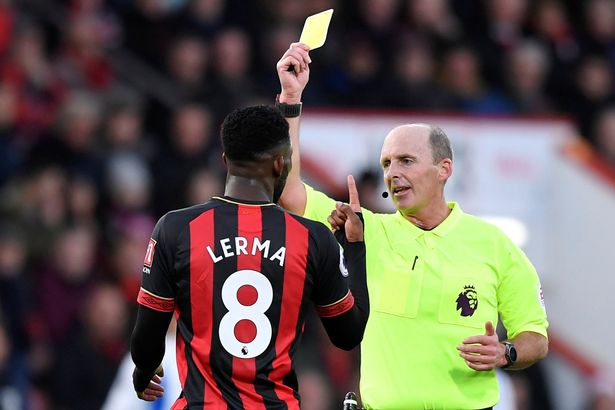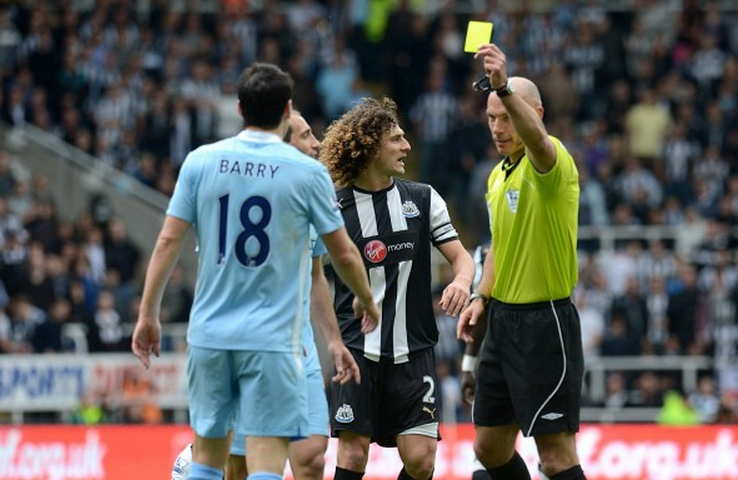Picking up a yellow card in itself means you are at risk of being sent off if you receive another yellow card. However, a lot of people are not as clear on the risks of getting multiple yellow cards in a season.
What happens when you get 10 yellow cards in the Premier League? If a player accumulates 10 yellow cards prior to their team’s 32nd fixture of the league they receive a two-match ban in the Premier League.

To discourage players from accumulating yellow cards, Premier League players are punished if they collect too many yellow cards in a season. This is in the form of match bans. If a player reaches 10 yellow cards prior to their team’s 32nd fixture in the Premier League then they will receive a two-match ban for the competition.
This is a follow-on from the initial rule which is that if a player accumulates five bookings within their teams’ first 19 Premier League games then they will serve a one-match ban for the Premier League.
Top 10 Players with yellow cards 2021-22 Premier League Season
| Rank | Player | Team | Yellow Cards |
| 1 | T. Mings | Aston Villa | 11 |
| 2 | J. Tarkowski | Brighton | 11 |
| 3 | Junior Firpo | Leeds | 11 |
| 4 | G. Xhaka | Arsenal | 10 |
| 5 | Y. Bissouma | Brighton | 10 |
| 6 | J. Bednarek | Southampton | 10 |
| 7 | C. Gallagher | Crystal Palace | 10 |
| 8 | Bruno Fernandes | Manchester Utd | 10 |
| 9 | J. Brownhill | Brighton | 10 |
| 10 | A. Rudiger | Chelsea | 9 |
When do Yellow cards reset in the Premier League?
Premier League players can receive bans if they accumulate too many yellow cards, with the Premier League having a one-game ban if a player accumulates five yellow cards in the first 19 games. This means that yellow card accumulation resets for all Premier League players after the team’s 19th game.
Players do still run the risk of receiving a one-game ban if they collect five yellow cards in the second half of the season. But the halfway point of the season essentially acts as a reset for yellow card accumulation when it comes to receiving a one-game ban for getting five yellow cards.
However, this is not the case for the possibility of a two-game suspension as the rules are different. This risk resets when a team plays its 32nd fixture in the Premier League in that season. After the 32nd fixture, a player cannot receive a two-game ban for accumulating 10 yellow cards as it has been reset and there are not enough games to do it in.
Yellow Card suspension rules Championship
As each of the leagues in the EFL has four more teams in each of the leagues, it means there are eight more games played per season than the Premier League. This means that the yellow card suspension rules have to be different to the Premier League.
The first two suspension rules are the same as the Premier League. If a player accumulates five yellow cards prior to week 19 then they will be suspended for a single game. A player’s yellow card count essentially resets after week 19. If a player accumulates ten yellow cards prior to week 32 then they will be suspended for two games.
However, the EFL has a different rule than the championship. It states that if a player accumulates 15 yellow cards prior to week 38 of the season then they will receive a three-match ban. This is a rarely used rule as players don’t usually accumulate yellow cards that quickly particularly if they have already been banned.
The EFL do have a process if a player is able to accumulate 20 yellow cards in a single season. If this happens then the regulatory commission will punish the player in a manner that they deem to be the most fitting. These rules are the case for the Championship, League One and League Two.
The exact punishment is up to the regulatory board and it can vary although this rarely ever happens.
Who has the most yellow cards in Premier League history?
The most yellow cards in Premier League history is probably not a record that any player wants to hold. It is Gareth Barry who holds that record, with an incredible 118 yellow cards across a very long career in the Premier League which spanned over 20 years.

Barry made his Premier League debut all the way back in the 1997/98 season. It did not take long for Barry to begin racking up the yellow cards, getting three In his second season in the Premier League before six in his third season. Barry became one of the first names on the team sheet for Aston Villa in the mid-2000s and the yellow cards began to rise.
He hit double digits for the first time in the 2002/03 season when he became Aston Villa’s key midfielder. Through his time with Villa Barry received more than one yellow card in each season and these yellows continued when he moved to Manchester City.
As Barry started to get older he did not have the same agility or recovery speed and it meant there were more tactical fouls in his game. Barry moved to Everton in 2013 and accumulated 35 yellow cards in four seasons with the Blue side of Liverpool, picking up four in his final season in the Premier League with West Brom.
Barry was a combative defensive midfielder whose job was to break up opposition attacks. The large majority of the time he did it legally and this is why Barry played 53 times for his country. However, this style meant he often chose to foul opponents when he could not stop them legally and this is where he racked up the yellow cards.
